 |
|
| hard corals text index | photo index |
| Phylum Cnidaria > Class Anthozoa > Subclass Zoantharia/Hexacorallia > Order Scleractinia > Family Euphylliidae |
| Euphyllia
corals Euphyllia sp. Family Euphylliidae updated Nov 2019 Where seen? These distinctive hard corals with long tentacles, most with U-shaped tips are sometimes seen on some of our shores. Features: Euphyllia corals are among the few hard corals that are identified by the shape of the polyp rather than just the skeleton. In fact, some Euphyllia species cannot be identified just by their skeleton alone. The polyps are long and often fully extended during the day, partially at night. Most Euphyllia species produce long sweeper tentacles that can sting powerfully. These tentacles keep the area near the colony clear of other competing animals such as other corals and encrusting organisms. The various Euphyllia species have different shaped tentacle tips that give rise to their common names. The shape of the colony is also different, but these are usually obscured when the long polyps are extended. Below is more on how to tell apart the different Euphyllia species. According to the Encyclopedia of Life, it is thought that the differences in the shape of tentacles between Euphyllia species may be related to specialised feeding habits. Unlike many other corals, Euphyllia tentacles do not possess clusters of stinging cells, and so may be adapted to capture food particles using water and cilia (microscopic hair-like projections). Sometimes confused with Pearl bubble coral which has round grape-like bubbles when fully inflated. Euphyllia babies: Euphyllia corals have separate male and female colonies (not all corals do), and most release eggs and sperm for external fertilization in the water, which then form larvae. Some of those that live along the equator, however, may brood larvae internally. Human uses: These corals are among those taken for the live aquarium trade, often in unsustainable numbers. Status and threats: All Euphyllid corals recorded for Singapore are listed as globally threatened by the IUCN. Like other creatures of the intertidal zone, they are affected by human activities such as reclamation and pollution. Trampling by careless visitors, and over-collection also have an impact on local populations. |
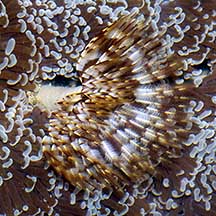 Fan worm in the middle of the colony. |
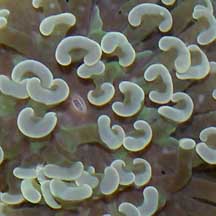 Mouth in the middle of the tentacles. Sisters Island, Jun 07 |
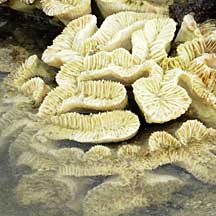 Sadly, these corals are often the first affected during mass coral bleaching. Terumbu Semakau, Jun 10 |
| Some Euphyllia corals on Singapore shores |
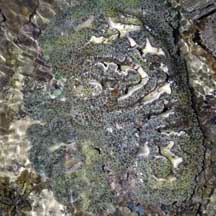 |
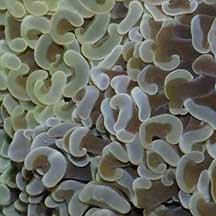 |
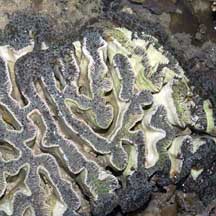 |
|
Brain
anchor coral
Euphyllia ancora |
Polyps
have long tentacles (2-3cm) with a U-shaped tip
|
Corallites
long and branching, forming meandering valleys with separate walls
(flabello-meandroid).
|
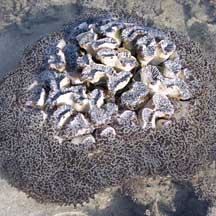 |
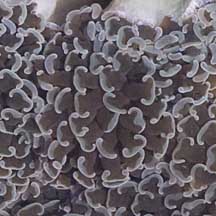 |
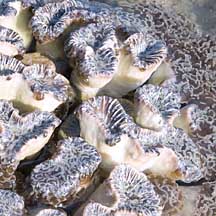 |
|
Branching
anchor coral
Euphyllia paraancora |
Polyps
have long tentacles (2-3cm) with a U-shaped tip.
|
Corallites
trumpet-shaped
(phaceloid) and branching. |
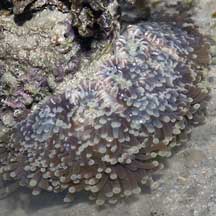 |
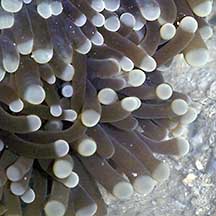 |
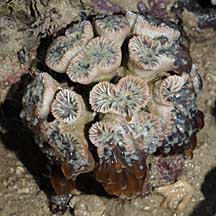 |
|
Torch
coral
Euphyllia glabrescens |
Polyps
have long tentacles (2-3cm) with a rounded tip (not U-shaped).
|
Corallites
trumpet-shaped
(phaceloid) and branching. |
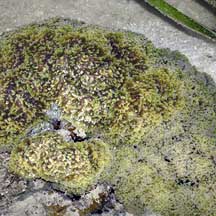
|
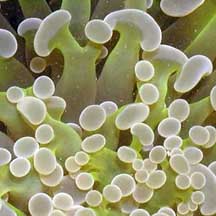 |
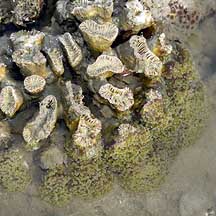 |
|
Frog
spawn coral
Euphyllia paradivisa |
Polyps
have long tentacles (2-3cm) that are branched at the tips into masses
of ball-shaped
and U-shaped tips. |
Corallites
long and tubular (phaceloid) and branching.
|
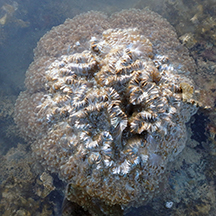 |
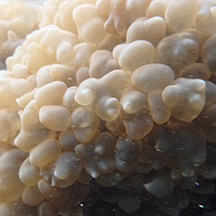 |
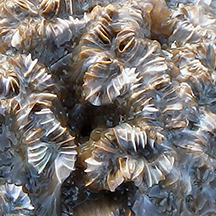 |
Pearl bubble coral Plerogyra sinuosa |
Bubbles (1-2cm) that resemble clusters of grapes when inflated. |
Corallites
brain-like meandering short, widely separated valleys, made up of large coin-like disks |
| Euphyllia
species recorded for Singapore from Danwei Huang, Karenne P. P. Tun, L. M Chou and Peter A. Todd. 30 Dec 2009. An inventory of zooxanthellate sclerectinian corals in Singapore including 33 new records **the species found on many shores in Danwei's paper. in red are those listed as threatened on the IUCN global list. *Groups based on in Veron, Jen. 2000. Corals of the World. +from our observation
|
|
Links
References
|